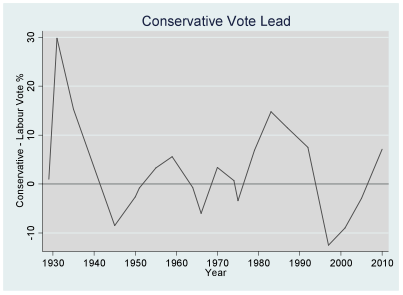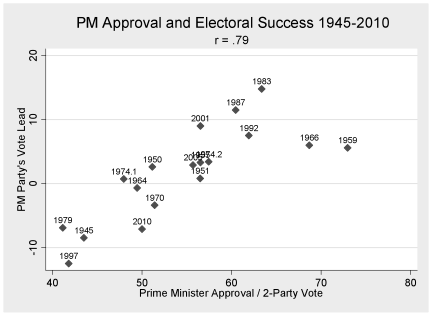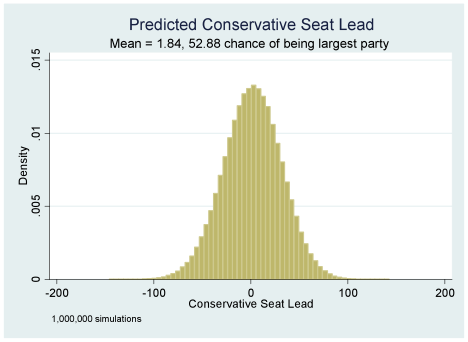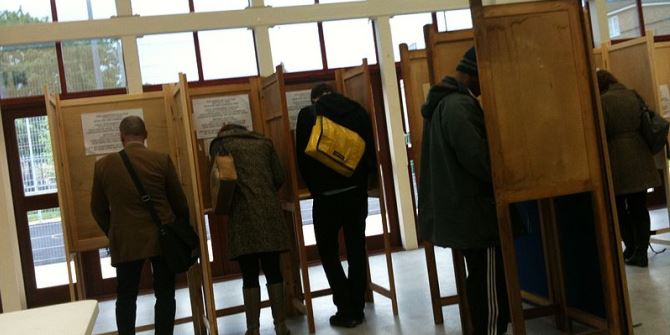
 Last week, a group of academics gathered at LSE to discuss a variety of forecasting models. In this post, Matthew Lebo and Helmut Norpoth, both professors of political science at Stony Brook University in New York, discuss their PM-and-Pendulum model. Their model favours the Conservatives in terms of parliamentary seats, though predicts that Cameron will not win a majority. Further, they suggest that the SNP is likely to win 41 of 59 Scottish seats.
Last week, a group of academics gathered at LSE to discuss a variety of forecasting models. In this post, Matthew Lebo and Helmut Norpoth, both professors of political science at Stony Brook University in New York, discuss their PM-and-Pendulum model. Their model favours the Conservatives in terms of parliamentary seats, though predicts that Cameron will not win a majority. Further, they suggest that the SNP is likely to win 41 of 59 Scottish seats.
In the general election on May 7, 2015, the Conservatives will edge the Labour Party and retain a narrow lead of seats in the House of Commons. But they will fall short of a majority. Hence, another Hung Parliament! This forecast comes from a statistical model of British general elections, which predicts that the Tories will come out ahead of Labour by a margin of 3.4 percent of the national vote. This will net the Tories 288 seats to Labour’s 286.
A key predictor of the vote forecast is the swing of the electoral pendulum. Over the past 75 years party control of the House of Commons has swung back and forth with some discernible regularity. The governing party can expect to last between two to three terms in office. Then the electoral pendulum swings back, giving the opposition party control of the Commons. Having just completed one term, the Conservatives are poised to come out ahead again.
Diminishing this advantage is the approval rating of the Prime Minister, the other predictor of the model. With an approval rating of barely 50 percent, as a proportion of the two-party vote, David Cameron enters the last few weeks before Election Day as a not very popular prime minister. Few in his position with such a low approval have led their party to resounding victories.
For the upcoming election, the presence of a coalition partner in the government—quite rare in British politics—has forced us to modify the PM-Pendulum Model.
One modification concerns the approval rating of the prime minister. The participation of the Liberal Democrats in Cameron’s government gives the prime minister a higher rating than he would have without them. This boost, however, does not help the Conservatives in the competition with Labour. Hence, in order to predict the vote lead of Conservatives over Labour we had to adjust Cameron’s approval rating accordingly, lowering it to the value used for the forecast (50%).
The other modification concerns the Conservative vote lead over Labour. The coalition with the Conservatives has cost the Liberal Democrats in voter support, prompting a wave of defection among their 2010 voters to the Labour Party this time. While the Conservatives also benefit somewhat from such defections, we estimate that the net result is a 3%-gain for Labour in the 2015 election. Our prediction of the Conservative vote lead over Labour has made an adjustment for that Labour gain.
Thus our forecast for the election is a 3.4% lead for the Conservatives. Simulation exercises give us some measure of uncertainty, shown here:
A Labour lead among the voters is possible, but quite unlikely in our forecast. Likewise, a large enough Conservative lead to produce a majority for Cameron is quite unlikely.
The seat forecasts for 2015 use a model that translates the Conservative vote lead votes into seats, with an adjustment for the seat distribution in the last general election. This translation has worked heavily in Labour’s favor in recent elections and continues to do so. A vote lead of 3.4 percent forecasts a lead of just two seats for the Tories with 288 and Labour with 286. Election simulations show the race to be neck-and-neck with neither party having much chance of a large lead in seats.
Separately, and based on current polls showing them roughly 20 points ahead of Labour, we predict the Scottish Nationalists (SNP) to win 41 seats in the General Election, a gain of 35 seats, with Labour taking the remaining 18 seats in Scotland. This is based on analysis of how votes have translated into seats over time in Scotland.
 Matthew Lebo is Professor of Political Science and the Director of the Centre for Behavioural Political Economy, Stony Brook University
Matthew Lebo is Professor of Political Science and the Director of the Centre for Behavioural Political Economy, Stony Brook University
 Helmut Norpoth is Professor of Political Science, Stony Brook University
Helmut Norpoth is Professor of Political Science, Stony Brook University












If the SNP gain BRS, DCT and Orkney and Shetland then I fail to see how Labour hold more than four seats at the very most, probably just a reduction to Glasgow NE and Murphy’s seat, and possibly zero.